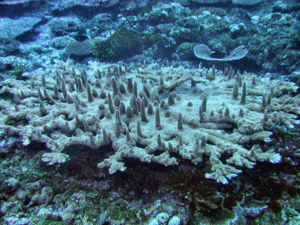Acropora abrotanoides facts for kids
Quick facts for kids Acropora abrotanoides |
|
|---|---|
 |
|
| Conservation status | |
| Scientific classification | |
| Synonyms | |
|
List
|
Acropora abrotanoides is a type of coral that lives in the ocean. It's found in warm waters, especially in the Indo-Pacific region. This includes places like the Red Sea, Japan, and Australia. You can find it in shallow coral reefs, often where strong waves hit. It usually lives at depths up to 15 meters (about 50 feet). This coral can be harmed by things like coral bleaching, diseases, and crown-of-thorns starfish. Luckily, it has special parts that help protect it from predators.
Contents
What is Acropora abrotanoides?
Acropora abrotanoides is a species of acroporid coral. It was first described in 1816 by a scientist named Lamarck. He originally called it Madrepora abrotanoides. For a while, another coral called Acropora irregularis was thought to be a different species. But now, scientists know they are actually the same.
What Does This Coral Look Like?
This coral grows in large groups called colonies. These colonies can spread out across the seabed, sometimes up to 3 meters (about 10 feet) wide. They can even form shapes like tables. In the middle of a colony, the coral branches grow together. The outer branches often grow upwards.
Coral Branches and Polyps
The branches of Acropora abrotanoides have small cup-like structures called corallites. These are where the tiny coral animals, called polyps, live. There are two main types of corallites:
- Axial corallites: These are usually at the tips of the branches.
- Radial corallites: These stick out from the sides of the branches. They have special, well-developed tips. These tips help protect the coral from animals that might try to eat it.
Colors and Similar Corals
This coral can be different colors, like green-grey or pink-brown. It looks a bit like two other types of coral: Acropora pinguis and Acropora robusta.
Where Does Acropora abrotanoides Live?
Acropora abrotanoides is found in a very wide area of the world's oceans. Its home stretches from the Gulf of Aden and the Red Sea in the west. It goes all the way through the Indian Ocean to the Pacific Ocean and the East China Sea. You can also find it near Australia and Japan. It has even been seen in the southeastern Atlantic Ocean.
What Threats Does This Coral Face?
Even though Acropora abrotanoides is currently listed as a "least concern" species by the IUCN Red List, its numbers are thought to be going down. It is also protected under CITES Appendix II. This means that trade of this coral is controlled to make sure it doesn't become endangered.
Dangers to Coral Reefs
The biggest threats to this coral, and to coral reefs everywhere, include:
- Global warming: Rising ocean temperatures cause coral bleaching. This is when corals get stressed and lose their color, which can lead to them dying.
- Climate change: Changes in the climate affect ocean conditions, making it harder for corals to survive.
- Human activities: Pollution, overfishing, and damage from boats can harm coral reefs.
- Diseases: Corals can get sick from various diseases.
- Crown-of-thorns starfish: These starfish (Acanthaster planci) are natural predators of coral. When there are too many of them, they can cause a lot of damage to reefs.


